Hospital worker: just compensate with an agreement, act on the territory
Hta, Cicchetti: a control room on drugs and medical devices
They do so in a position paper of their scientific society, the SIHTA, which brings together 200 members of various backgrounds: clinical engineers, public and private health managers, health and drug economists, hospital pharmacists, heads of pharmaceutical departments of ministries and regions, Aifa and Agenas operators.
In articles 26 and 27, the government-regions pact establishes a control room by co-opting the Aifa drug agency and the Agenas health services agency to evaluate biomedical and pharmaceutical technologies: Italy is faced with the task of classifying medical devices in homogeneous categories and to organize their effectiveness tests in the regions; while on drugs it must evaluate the comparative effectiveness by producing "reliable, transparent and transferable" data for AIFA.
«Non siamo in contrapposizione con Aifa e Agenas, tutt’altro. La nostra società non si propone come ente di produzione di valutazioni HTA, ma intende mettere l’esperienza dei propri associati al servizio delle istituzioni: oggi in Italia disponiamo di professionalità e centri di ricerca che possono contribuire a produrre dati importanti», dice il neoeletto presidente Sihta Americo Cicchetti. And he explains:
«Mentre per i farmaci l’Aifa definisce sia l’ingresso nei livelli essenziali di assistenza sia i prezzi, non c’è un percorso istituzionalizzato per governare l’introduzione nella pratica clinica di dispositivi e procedure. Non abbiamo ad esempio un approccio unico per garantire un uso appropriato del robot chirurgo o per dire se stiamo spendendo troppo per un device, o per giudicare le prestazioni di un dispositivo.
Né è previsto fin qui un percorso per valutare quale combinazione di nuovi farmaci anti-epatite C vada assicurata ai cittadini, potendo disporre – a breve – di 5-6 nuovi principi. Per un simile compito il Patto individua lo strumento di coordinamento nella cabina di regia, da noi fortemente sostenuta come punto di partenza», osserva Cicchetti.
«Ma per ottimizzare gli sforzi occorre secondo noi non trascurare le competenze di professionisti che questo lavoro lo fanno ogni giorno. E occorre altresì favorire il dialogo tra il nascente Programma nazionale di HTA e l’Health Technology Assessment Network (HTA-N) che rappresenta i 28 stati Ue: l’esperienza avanzata di molti paesi europei può e deve venirci in aiuto, e ci sollecita, quanto prima, l’avvio della Cabina di Regia proprio per creare un legame strutturale tra livello nazionale ed europeo, evitare duplicazioni e accelerare il lavoro di valutazione».
Mauro Miserendino
Saturday, 04 October 2014 – Doctor33
Hospital worker: just compensate with an agreement, act on the territory
An underestimation of hospital expenditure, which cannot be included in a monthly monitoring, but is often calculated in the final balance. With the consequence that then it is the contracted party who pays for it. The case comes from Piedmont and was highlighted by Maximum Mana, president of regional Federfarma, but it could also apply to other regions.
«Intanto la territoriale è più alta di quanto indicato dalla Regione e a ballare sono 80 milioni». Non quindi il totale di 827,8 ma «907 pari al 11,35% del fondo sanitario nazionale». Idem sull’ospedaliera, che ha un valore più basso: «in realtà 280 milioni di tetto contro il limite di 390 indicato dalla Regione. E già adesso le stime dell’assessorato dicono che l’ospedaliera è arrivata a 415 milioni». Perché queste discrepanze?
«I desiderata della Regione potrebbero essere di arrivare a un determinato valore complessivo di spesa farmaceutica, in modo che il discostamento dal tetto appaia inferiore – al momento la cifra si aggira intorno ai 1200 milioni, contro i 1187 previsti dal tetto complessivo. E il meccanismo è di considerare spesa ospedaliera e convenzionata come vasi comunicati».
With a consequence: «I would hope not, I would hope that, as often happens, it is only about announcements, but I cannot exclude that meetings with the Region may arise from here in which further sacrifices are asked for on the agreement. And I can already say that the territory is no longer capable of withstanding interventions».
Tra i problemi alla base di questa situazione c’è la difficoltà di monitorare la spesa ospedaliera, che consentirebbe anche di fare una più corretta programmazione: «Credo che un punto affermato dall’assessore sia proprio quello di essersi reso conto che i dati sono sottostimati e che ci sarebbe bisogno di inquadrare la spesa ospedaliera mensilmente. Mentre spesso la vera entità di questa voce arriva dal consuntivo».
That said, "the problem of hospital expenditure is in any case structural: acute patients must flow to the hospital while chronic patients must be treated in the area, between first-level structures and the patient's home", with a more important role also for pharmacies.
Frances Giani
